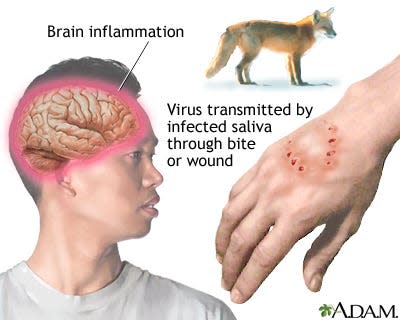Almost 1,500 cases of exposure to rabies confirmed in Florida. Lee County is in Top-10
Lee County is on the rabies radar for 2024.
Two and half months into the new year, the Florida Department of Health reports that Lee County is in the Top-10 in the state for cases confirmed as possible exposures to the virus. As of Friday (March 15) Lee was No. 7 on the cases list with 70 reports. Collier County has had 28 reports.
Broward County topped the list with 125 cases since Jan. 1.
Here's what you should look out for, including how to protect yourself and your pets.
More: Conservancy scores big win against Burmese pythons - most wanted invasive species in Florida
Florida reports more than 1,000 cases of rabies exposure since Jan. 1
As of March 15, the Florida Department of Health reported there have been 1,446 cases of exposure to rabies confirmed since Jan. 1, with 1,417 of the instances of exposure happening in Florida. There have been reports in 53 of Florida's 67 counties so far this year.
The breakdown by month:
January: 553
February: 645
March (to date): 248
What is rabies?

Rabies is a fatal but preventable viral disease, the Centers for Disease Control said.
It can spread to people and pets if they are bitten or scratched by a rabid animal or the virus is spread by exposure to an animal's saliva through broken skin, according to the National Library of Medicine.
What animals are most likely to carry rabies?
What Florida counties have reported the highest number of exposure to rabies?
Top 10 counties, since Jan. 1:
Broward: 125
Miami-Dade: 115
Orange: 75
Pasco: 74
Polk: 73
Palm Beach: 72
Lee: 70
St. Lucie: 59
Volusia: 57
Escambia: 56
Exposure to rabies reports in Florida 2024
Alachua: 36
Bay: 11
Brevard: 31
Charlotte: 2
Citrus: 11
Collier: 28
Columbia: 1
DeSoto: 2
Dixie: 2
Duval: 39
Flagler: 2
Franklin: 2
Gadsden: 3
Gilchrist: 3
Hardee: 30
Hendry: 15
Hernando: 26
Highlands: 8
Hillsborough: 40
Indian River: 10
Jackson: 1
Leon: 43
Levy: 6
Madison: 2
Manatee: 19
Marion: 49
Martin: 13
Monroe: 3
Okaloosa: 10
Okeechobee: 6
Osceola: 25
Pinellas: 40
Putnam: 3
Santa Rosa: 11
Sarasota: 42
Seminole: 39
St. Johns: 32
Sumter: 1
Suwannee: 12
Taylor: 4
Wakulla: 1
Walton: 4
Washington: 2
Ages of those exposed to rabies in Florida so far in 2024
Ages 0-4: 47
Ages 5-9: 88
Ages 10-14: 70
Ages 15-19: 94
Ages 20-24: 141
Ages 25-29: 130
Ages 30-34: 127
Ages 35-39: 118
Ages 40-44: 99
Ages 45-49: 93
Ages 50-54: 72
Ages 55-59: 85
Ages 60-64: 90
Ages 65-69: 66
Ages 70-74: 65
Ages 75-79: 34
Ages 80-84: 17
Ages 85+: 10
How can you tell an animal has rabies?
You can’t tell if an animal has rabies by just looking at it; the only way to know for sure if an animal (or a person) has rabies is to perform laboratory testing, the CDC said.
Some things you can look for include:
General sickness.
Problems swallowing.
Excessive drool or saliva.
An animal that is overly aggressive.
An animal that bites at imaginary objects (sometimes called “fly biting”).
An animal that appears tamer than you would expect.
An animal that’s having trouble moving or may even be paralyzed.
A bat on the ground.
Can rabies be treated?
If you’ve been in direct physical contact with any wildlife or unfamiliar animals, especially if you’ve been bitten or scratched, talk with a healthcare provider to determine your risk for rabies or other illnesses, the CDC said.
One important factor in deciding if whether you should receive rabies vaccination — post exposure prophylaxis — will be if the animal you were exposed to can be found and tested for rabies or held for observation.
If you need rabies vaccination, it should be started soon after exposure.
Immunization given early (preferably within 24 hours but certainly within 72 hours) can usually prevent the disease.
Symptoms of rabies in people
After being exposed to rabies, the virus has to travel to the brain before it can cause symptoms. This period may last for weeks to months.
Of special note: "Once clinical signs of rabies appear, the disease is nearly always fatal, and treatment is typically supportive, the CDC said, emphasizing that if you think you've been exposed to rabies, seek medical care immediately.
The first symptoms of rabies may be similar to the flu, including weakness or discomfort, fever, or headache. There also may be discomfort, prickling, or an itching sensation at the site of the bite. These symptoms may last for days.
Symptoms then progress to cerebral dysfunction, anxiety, confusion, and agitation. As the disease progresses, the person may experience delirium, abnormal behavior, hallucinations, hydrophobia (fear of water), and insomnia.
How to protect your pet from rabies
Cats and dogs, and even livestock, can get rabies. Nearly all the pets and livestock that get rabies have not received vaccination or were not up to date on rabies vaccinations.
Most pets get rabies from having contact with wildlife.
Because laws require dogs to be vaccinated for rabies in the United States, dogs make up about 1% of rabid animals reported each year in the U.S.
That's not the case elsewhere, where exposure to rabid dogs is the cause of nearly all human rabies deaths worldwide, the CDC said.
Protect your pet by:
Keeping rabies vaccinations up to date.
Keeping cats and ferrets inside and keep dogs under supervision.
Keeping pets away from wildlife.
Spaying or neutering pets.
Calling animal control to remove stray animals
This article originally appeared on Fort Myers News-Press: Rabies in Lee County, Florida: Symptoms, what to watch for, treatment
